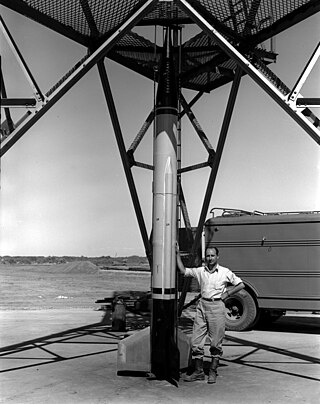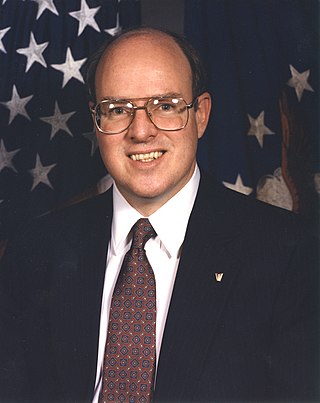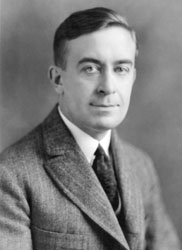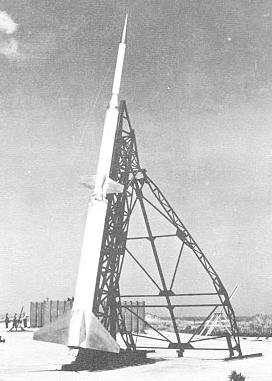
Hermann Julius Oberth was an Austro-Hungarian-born German physicist and rocket pioneer of Transylvanian Saxon descent. He is considered one of the founding fathers of rocketry and astronautics, along with Robert Esnault-Pelterie, Konstantin Tsiolkovsky, Robert H. Goddard and Herman Potočnik. Oberth supported Nazi Germany's war effort and received the War Merit Cross in 1943.

Robert Hutchings Goddard was an American engineer, professor, physicist, and inventor who is credited with creating and building the world's first liquid-fueled rocket, which was successfully launched on March 16, 1926. By 1915 his pioneering work had dramatically improved the efficiency of the solid-fueled rocket, signaling the era of the modern rocket and innovation. He and his team launched 34 rockets between 1926 and 1941, achieving altitudes as high as 2.6 km (1.6 mi) and speeds as fast as 885 km/h (550 mph).

The American Institute of Aeronautics and Astronautics (AIAA) is a professional society for the field of aerospace engineering. The AIAA is the U.S. representative on the International Astronautical Federation and the International Council of the Aeronautical Sciences. In 2015, it had more than 30,000 members among aerospace professionals worldwide.

The WAC Corporal was the first sounding rocket developed in the United States and the first vehicle to achieve hypersonic speeds. It was an offshoot of the Corporal program, that was started by a partnership between the United States Army Ordnance Corps and the California Institute of Technology in June 1944 with the ultimate goal of developing a military ballistic missile.

Robert Albert Charles Esnault-Pelterie was a French aircraft designer and spaceflight theorist. He is referred to as being one of the founders of modern rocketry and astronautics, along with the Russian Konstantin Tsiolkovsky, the Germans Hermann Oberth, Wernher Von Braun and the American Robert H. Goddard.

John D. Anderson Jr. is the Curator of Aerodynamics at the National Air and Space Museum at the Smithsonian Institution in Washington, D.C., Professor Emeritus in the Department of Aerospace Engineering at the University of Maryland, College Park.
Robert Godwin is a British author who has written about rock music and spaceflight. Early in his career he was a rock music impresario who managed a venue in Burlington, Ontario, and founded Griffin Music.

Richard P. Hallion is Senior Adviser for Air and Space Issues, Directorate for Security, Counterintelligence and Special Programs Oversight, the Pentagon, Washington, D.C. He is responsible for analysis and insight regarding the conceptualization, evolution and utilization of sensitive national technological programs and related subject areas.

Alfred Victor Verville was an American aviation pioneer and aircraft designer who contributed to civilian and military aviation. During his forty-seven years in the aviation industry, he was responsible for the design and development of nearly twenty commercial and military airplanes. Verville is known for designing flying boats, military racing airplanes, and a series of commercial cabin airplanes. His planes were awarded with the Pulitzer Speed Classic Trophy in 1920 and 1924.
Luigi Gussalli (1885–1950), engineer and inventor, was a pioneer of motor cars. He turned to astronautics in the 1920s, corresponding with world leaders in this field, such as Oberth and Goddard and exchanging with them theories on interplanetary flight and its prospects. He developed a special double-reaction engine, wrote extensively on multi-stage rockets and published two books on space travel. The first one, in 1923, described a space flight to the Moon, the second one, written in 1946, is even more astonishing in its theme: “Interplanetary travels by means of solar radiations”.

The Purdue University School of Aeronautics and Astronautics is Purdue University's school of aerospace engineering contained within the Purdue University College of Engineering. The school offers B.S., M.S., and Ph.D. degrees in aeronautical and astronautical engineering. It also provides distance graduate education, including an online M.S. in Engineering with concentration in Aeronautics and Astronautics, and a distance Ph.D. Its main office and some of its labs are located in the Neil Armstrong Hall of Engineering. As of 2010, the School has awarded an estimated 6% of BS degrees and 7% of PhDs in aerospace engineering in the United States.

Robert David Braun is an American aerospace engineer and academic. He has served as the dean of the College of Engineering and Applied Science at the University of Colorado Boulder, the David and Andrew Lewis Professor of Space Technology at the Georgia Institute of Technology, and the NASA Chief Technologist. Currently, Dr. Braun is the Space Sector Head at the Johns Hopkins University Applied Physics Laboratory (APL).
The Charles A. Lindbergh Chair in Aerospace History, also known as the Lindbergh Chair, is a one-year senior fellowship hosted by the U.S. National Air and Space Museum (NASM), to assist a scholar in the research and composition of a book about aerospace history. Named for the famous aviator Charles Lindbergh, the position is competitive: one experienced scholar is selected each year from multiple applicants worldwide. Up to $100,000 is granted to the winner.
Tom Day Crouch is an American aeronautics historian and curator.
Michael J. Neufeld is a historian and author. He chaired the Space History Division at the Smithsonian’s National Air and Space Museum from 2007 to 2011, and continues to be a curator there.

The Exos, originally designated RM-86 and later PWN-4, was a sounding rocket developed by the University of Michigan and NACA for use by the United States Air Force.

Roger D. Launius is an American historian and author of Lithuanian descent, a former chief historian of NASA. He retired in 2016 as Associate Director for Collections and Curatorial Affairs for the Smithsonian National Air and Space Museum in Washington, D.C. Launius is a consulting historian in air and space history. He has written many books on space flight, and also published on the history of the Latter Day Saint movement.

Tory Bruno is an American aerospace engineer and executive. He has been the CEO of United Launch Alliance (ULA) since August 2014. Before ULA, he worked at Lockheed Martin, where he made the transition from engineer to executive.

Mike Gruntman is a Russian-American physicist, space engineer, and author. He is professor of astronautics and aerospace engineering at the Viterbi School of Engineering, University of Southern California (USC).
Eugene Morlock Emme was an American air force pilot during World War II (1939–1945) who became a pioneering historian of aviation, and then the first historian of NASA's aerospace program.














